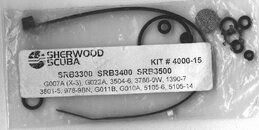keyshunter
Contributor
waterskier,
I would not throw out the "baby with the bathwater" on your Magnum. It is, however, imperative that you remove the flow restrictor or you will indeed need a new body. Depending upon the age of your reg, the flow restrictor will have either a scintered filter at the bottom (older style), in which case you replace the entire restrictor, or a small white foam puck filter (newer), in which case you just replace he foam. This foam filter is supplied in current Sherwood rebuild kits.
Many years ago, although I had done a stint as an industrial sewing machine mechanic, and was not concerned about digging into complicated mechanisms, I didn't want to bother with servicing my regs since I was in the water almost every day, had other regs, and was very busy. I returned a new Sherwood reg (the old model with the filter in the piston) to an LDS in the Keys 3 times because it "stuttered" with every breath. It was always returned with the same problem. Finally, with no manual, (that was before the internet) I took the first stage apart. I marveled at how simple it was, but could visually find nothing wrong, except that the o rings, particularly the large piston one, seemed dry. I lubed the o-rings, and put it back together. The stutter was gone and it went at least 300 dives before I touched it again. A lot of water has passed under my keel since that time, and, while I still utilize an LDS occasionally (usually because I cannot get parts), I do most of my reg service. While there are some excellent reg techs out there, they do seem to be in the minority. From your story above, you seem to have found a couple of beauts.
I would not throw out the "baby with the bathwater" on your Magnum. It is, however, imperative that you remove the flow restrictor or you will indeed need a new body. Depending upon the age of your reg, the flow restrictor will have either a scintered filter at the bottom (older style), in which case you replace the entire restrictor, or a small white foam puck filter (newer), in which case you just replace he foam. This foam filter is supplied in current Sherwood rebuild kits.
Many years ago, although I had done a stint as an industrial sewing machine mechanic, and was not concerned about digging into complicated mechanisms, I didn't want to bother with servicing my regs since I was in the water almost every day, had other regs, and was very busy. I returned a new Sherwood reg (the old model with the filter in the piston) to an LDS in the Keys 3 times because it "stuttered" with every breath. It was always returned with the same problem. Finally, with no manual, (that was before the internet) I took the first stage apart. I marveled at how simple it was, but could visually find nothing wrong, except that the o rings, particularly the large piston one, seemed dry. I lubed the o-rings, and put it back together. The stutter was gone and it went at least 300 dives before I touched it again. A lot of water has passed under my keel since that time, and, while I still utilize an LDS occasionally (usually because I cannot get parts), I do most of my reg service. While there are some excellent reg techs out there, they do seem to be in the minority. From your story above, you seem to have found a couple of beauts.
Last edited:



 - But I was 15 y/o and not charging anyone much less a Authorized Factory Repair Center for Renault]
- But I was 15 y/o and not charging anyone much less a Authorized Factory Repair Center for Renault]

